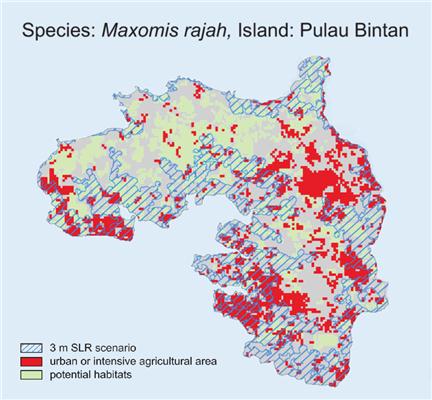Sea-level rise has been a cause for concern and studies indicate that within this century the sea will increase about 1-2 m and there will be changes in the global biodiversity and human life.

The Indonesian island of Pulau Bintan in a simulated sea-level rise (SLR) scenario of 3 meters. Blue stripes: flooded area; Red: densely populated or intensive agricultural area; Green: potential habitat of the Rajah Spiny Rat
The most immediate concern is flooding and inundation, which are being currently assessed. But research on the secondary impact such as relocation of people from coastal areas to the inland due to sea-level rise, has not been considered.
Florian Wetzel and Dustin Penn, lead author and senior researcher, respectively from the Konrad Lorenz Institute of Ethology, a part of the University of Veterinary Medicine, Vienna, along with scientists from the Ecoinformatics and Biodiversity Group of Aarhus University, Denmark, have studied the secondary impact and published their findings in the latest issue of Global Change Biology, an international journal. The researchers found that in highly populated places the loss due to secondary impact could be equal to or greater than loss occurring due to the primary impact.
The researchers from the Konrad Lorenz Institute of Ethology Florian Wetzel, Dustin Penn and Helmut Beissmann teamed with W. Daniel Kissling from the Ecoinformatics and Biodiversity Group for another study relating to possible ecological impact on habitat availability and dispersion of specific mammal species due to sea-level rise. They chose 1200 islands in the Southeast Asian and Pacific area for their research where they focused also on impacts due to 3 to 6 m sea-level rise. Around 3% and 32% of these islands’ coastal areas will be destroyed by the primary impact and 8 to 52 million people would become homeless. The dispersion and loss of animal species will be about 10% to 18% in the 1-2 m sea-level rise and 22% to 46% in the other case.
Florian Wetzel asserts that in order to identify ecologically vulnerable species and zones, it is very important to assess the secondary impacts of sea-level rise. It was also found that there were a number of variables to consider the vulnerability aspect. For example,
Oceania species were more vulnerable to primary impact while species in Indo-Malaysian islands would have to face the effects of the secondary impacts. Though all the findings are projections, Dustin Penn believes that it is imperative that effects of sea-level rise should include secondary impact as well.
Disclaimer: The views expressed here are those of the author expressed in their private capacity and do not necessarily represent the views of AZoM.com Limited T/A AZoNetwork the owner and operator of this website. This disclaimer forms part of the Terms and conditions of use of this website.